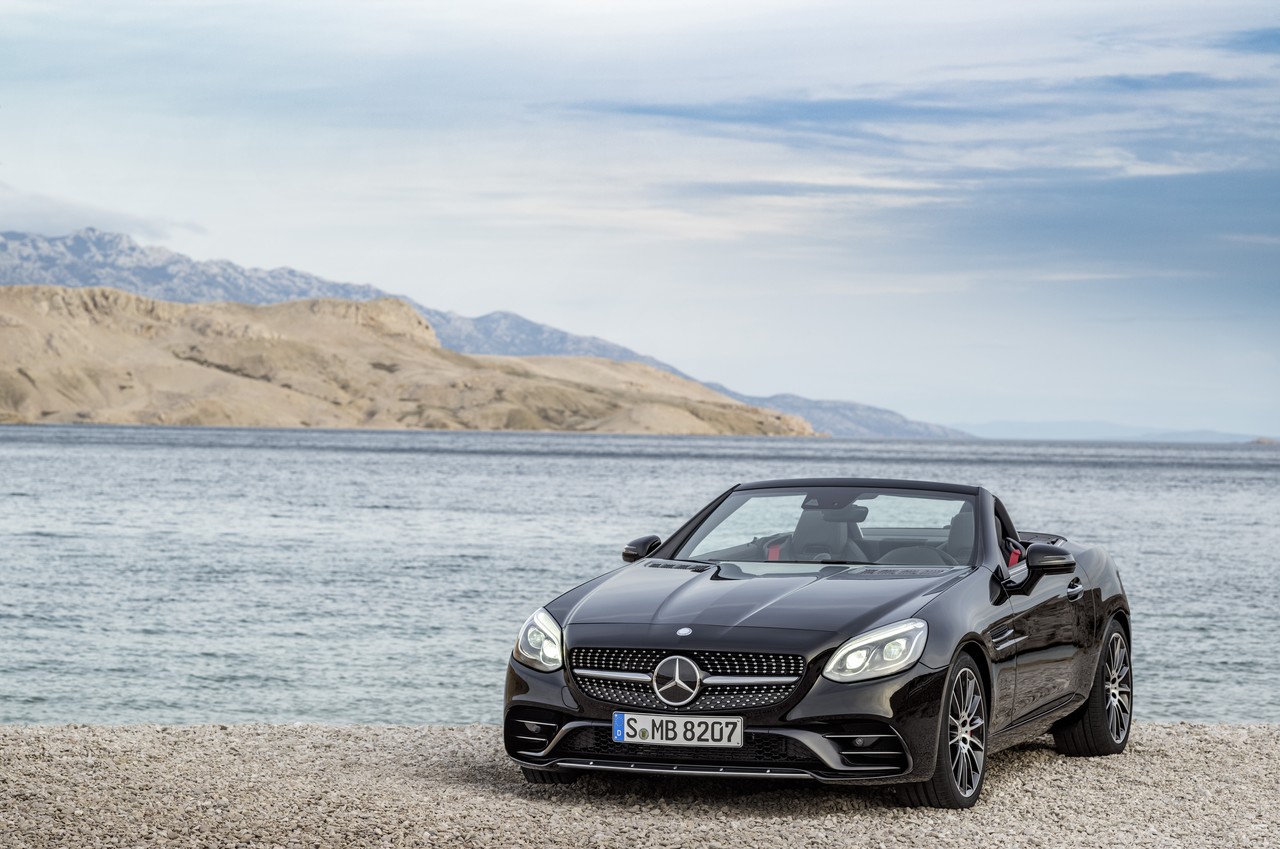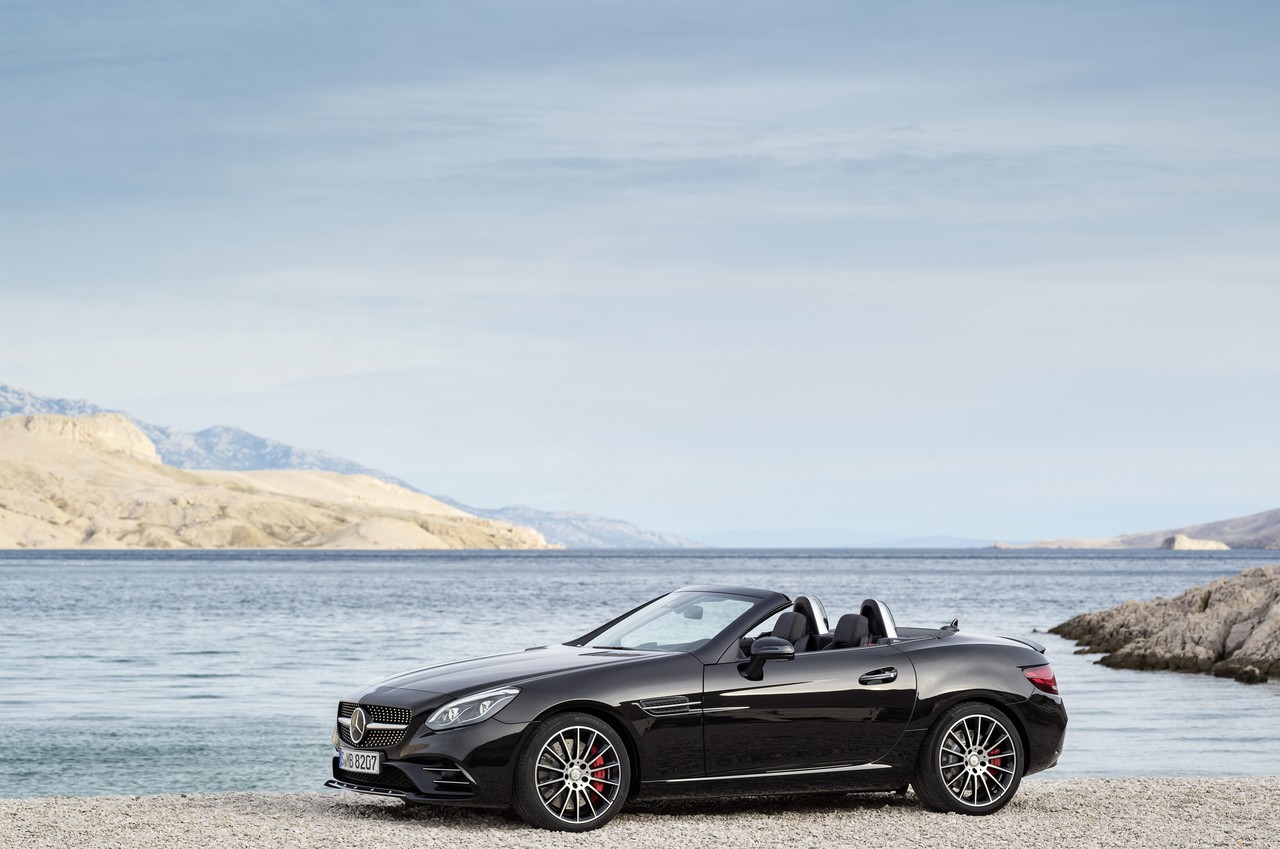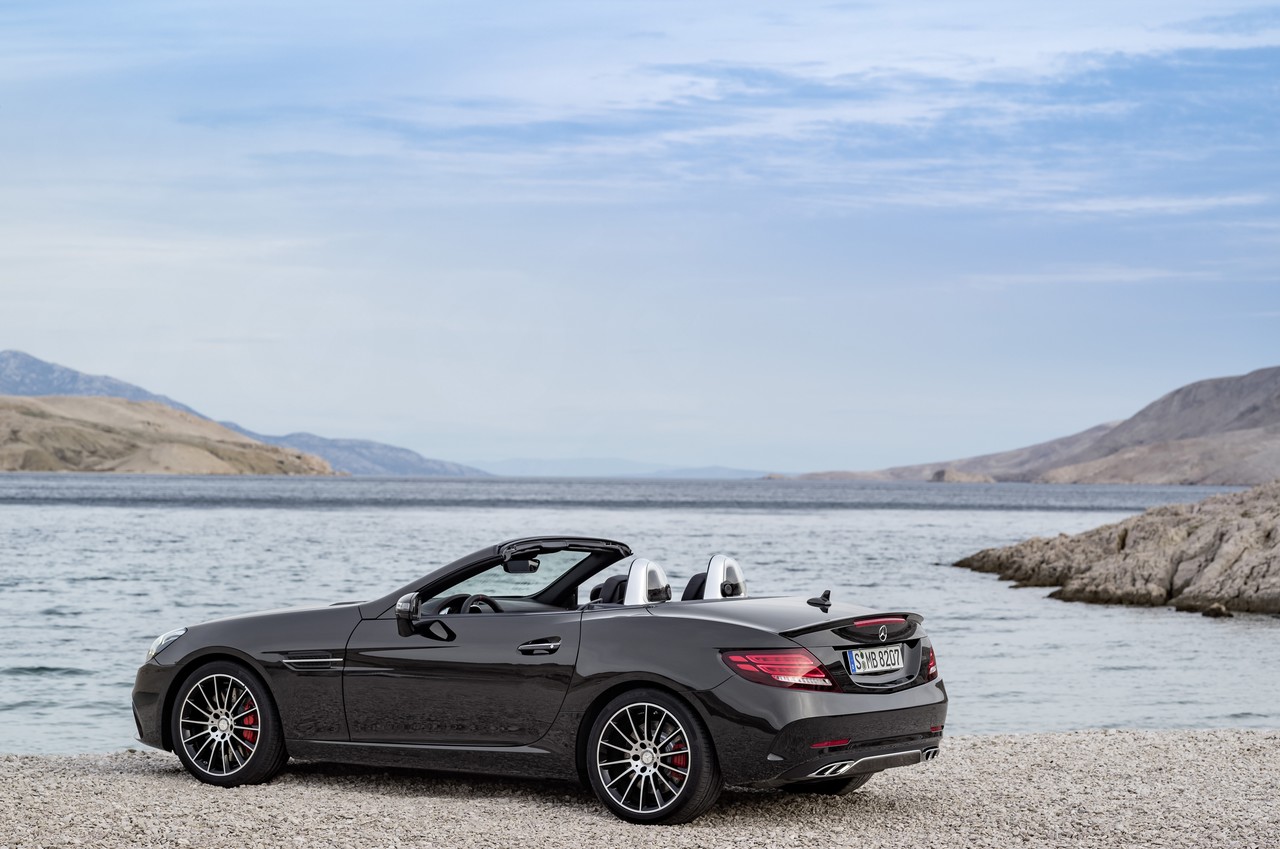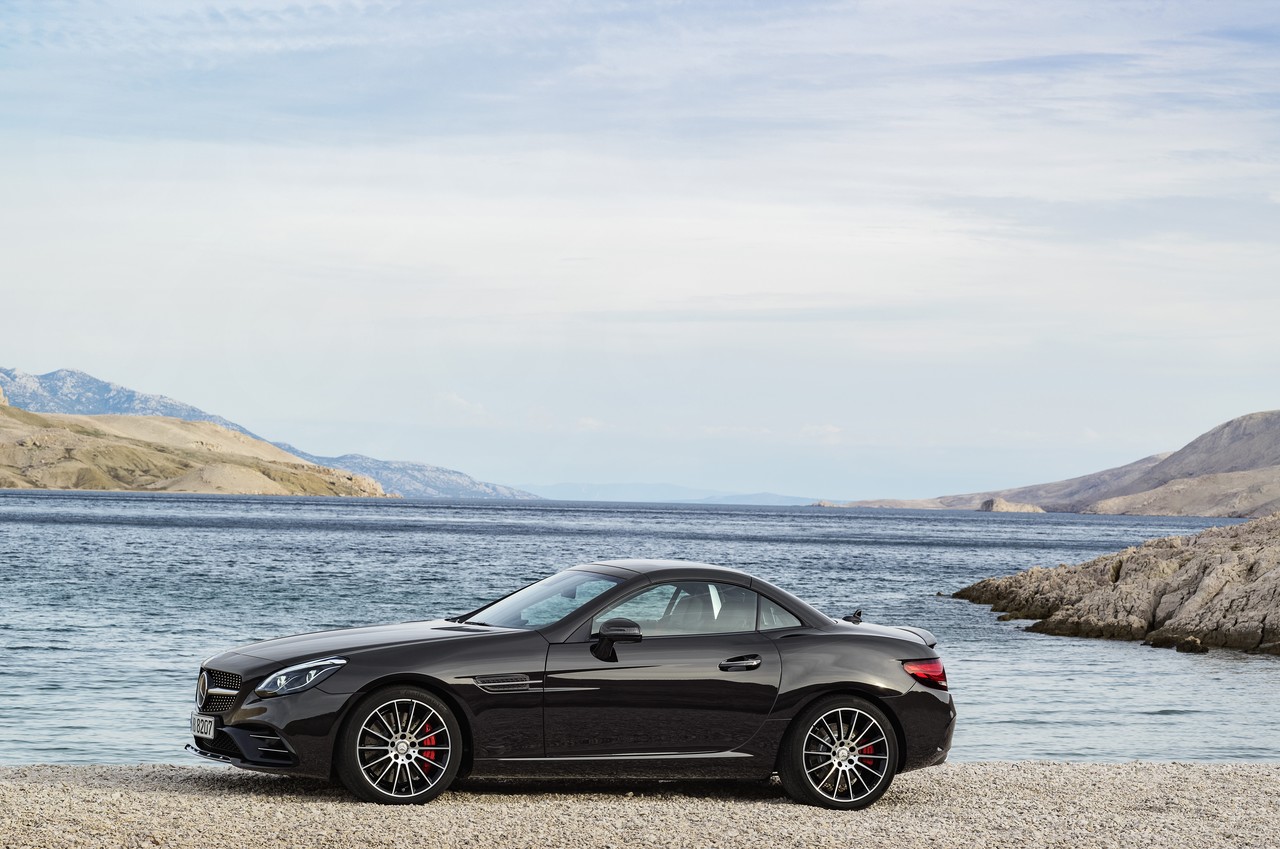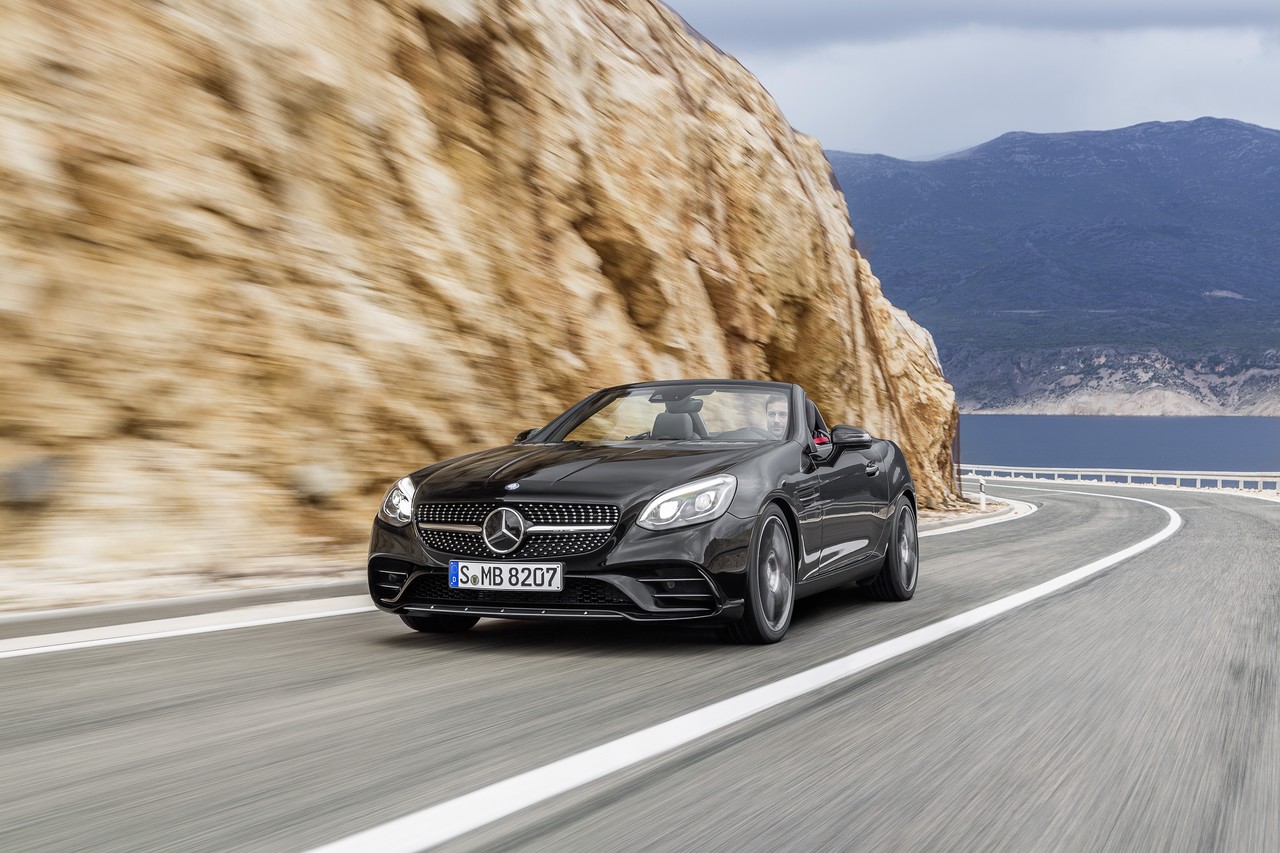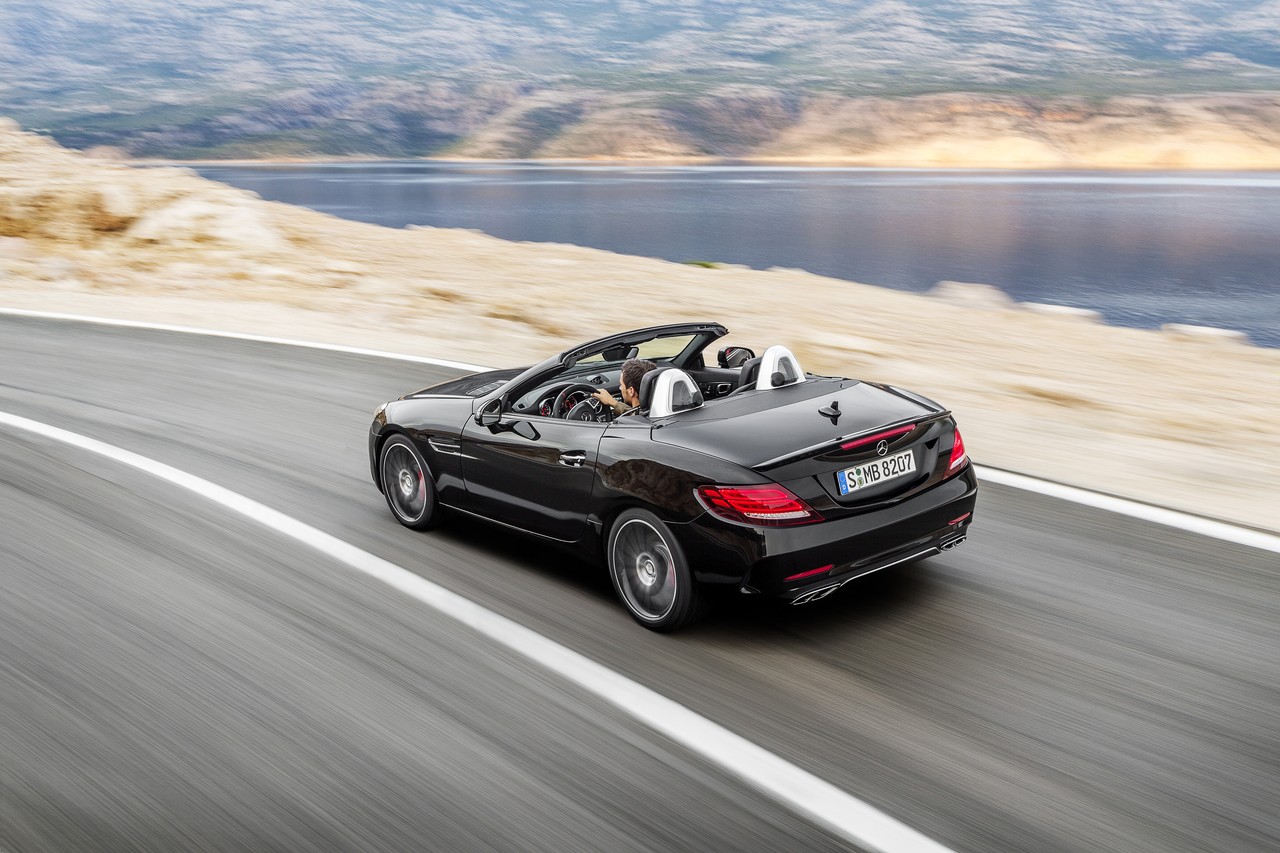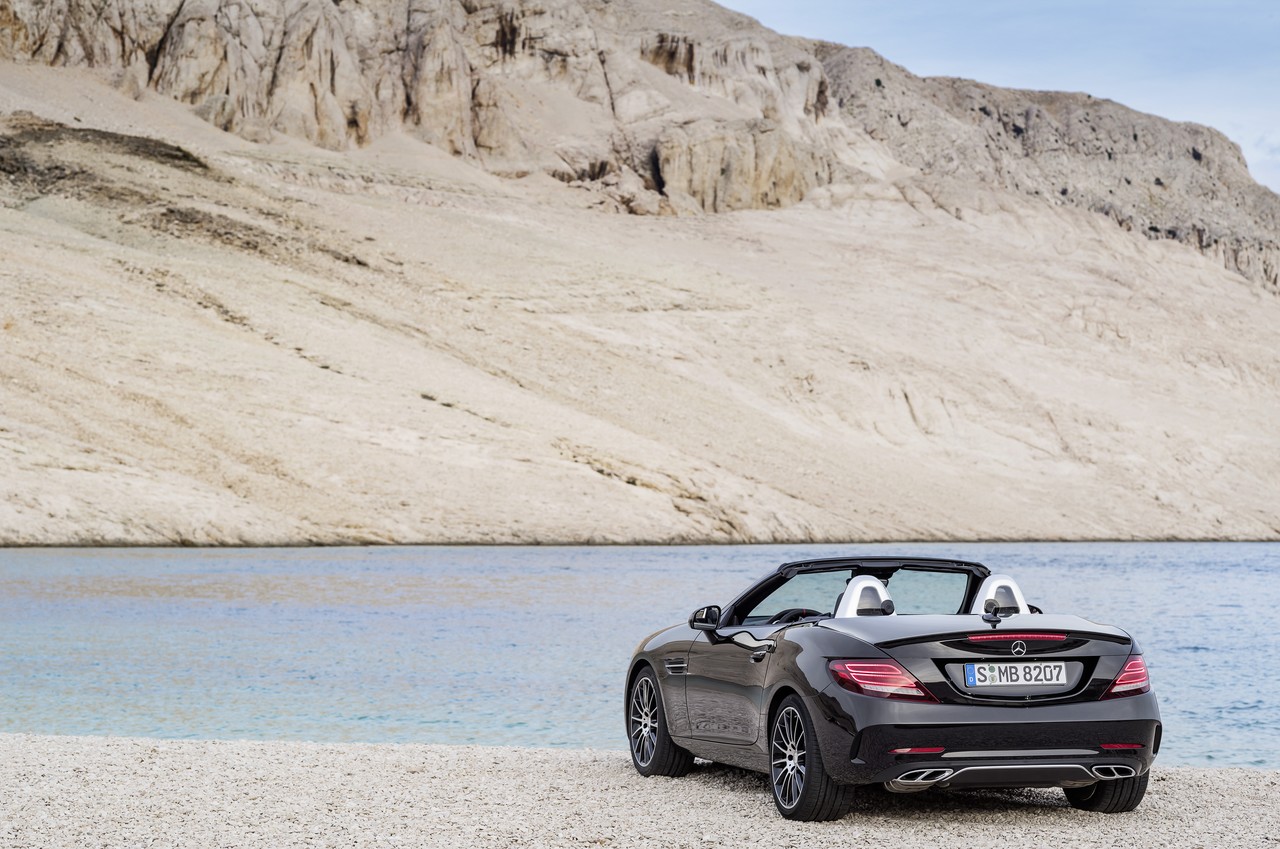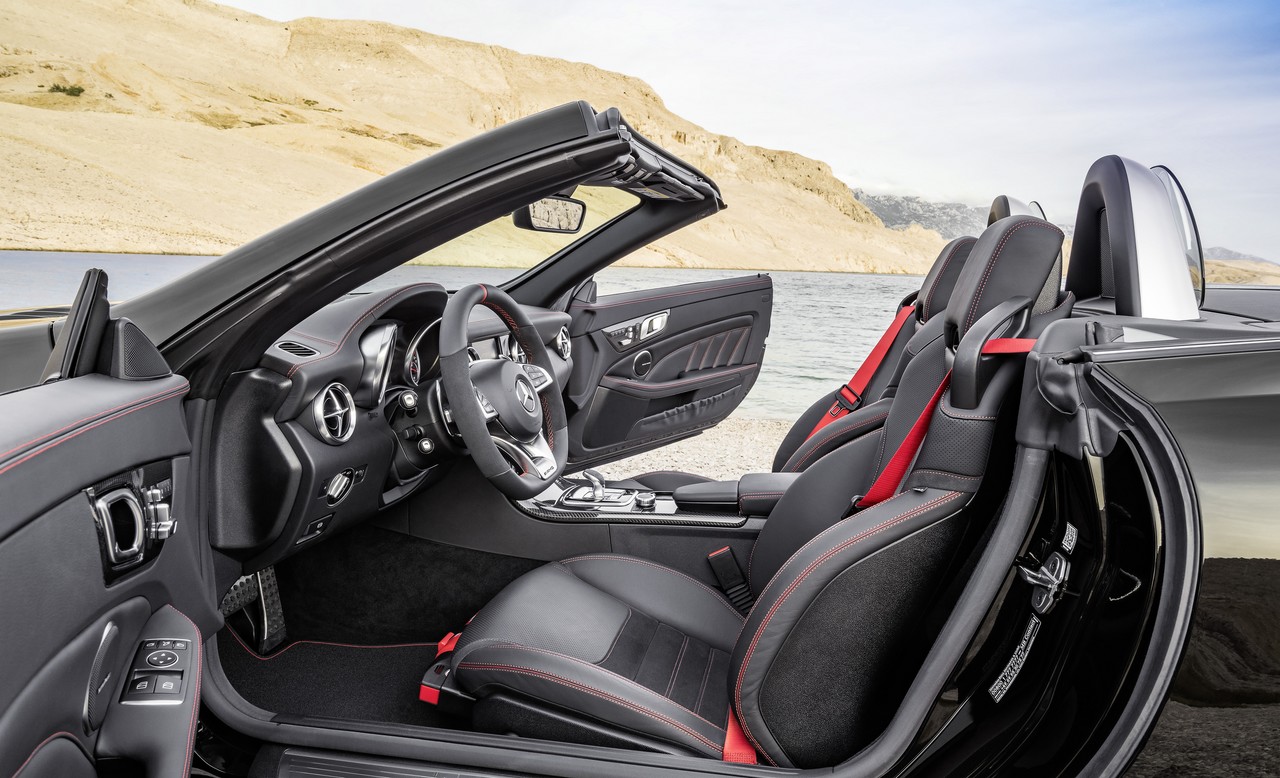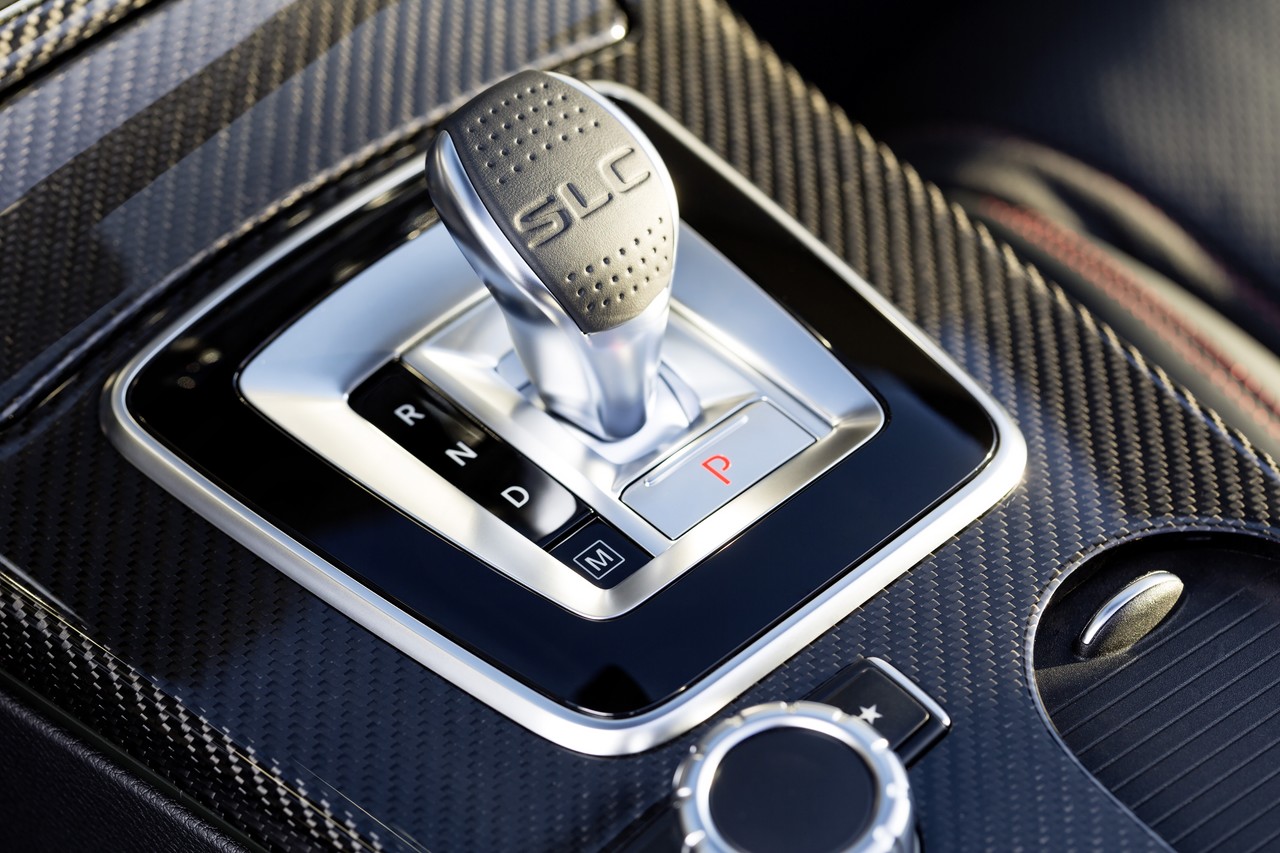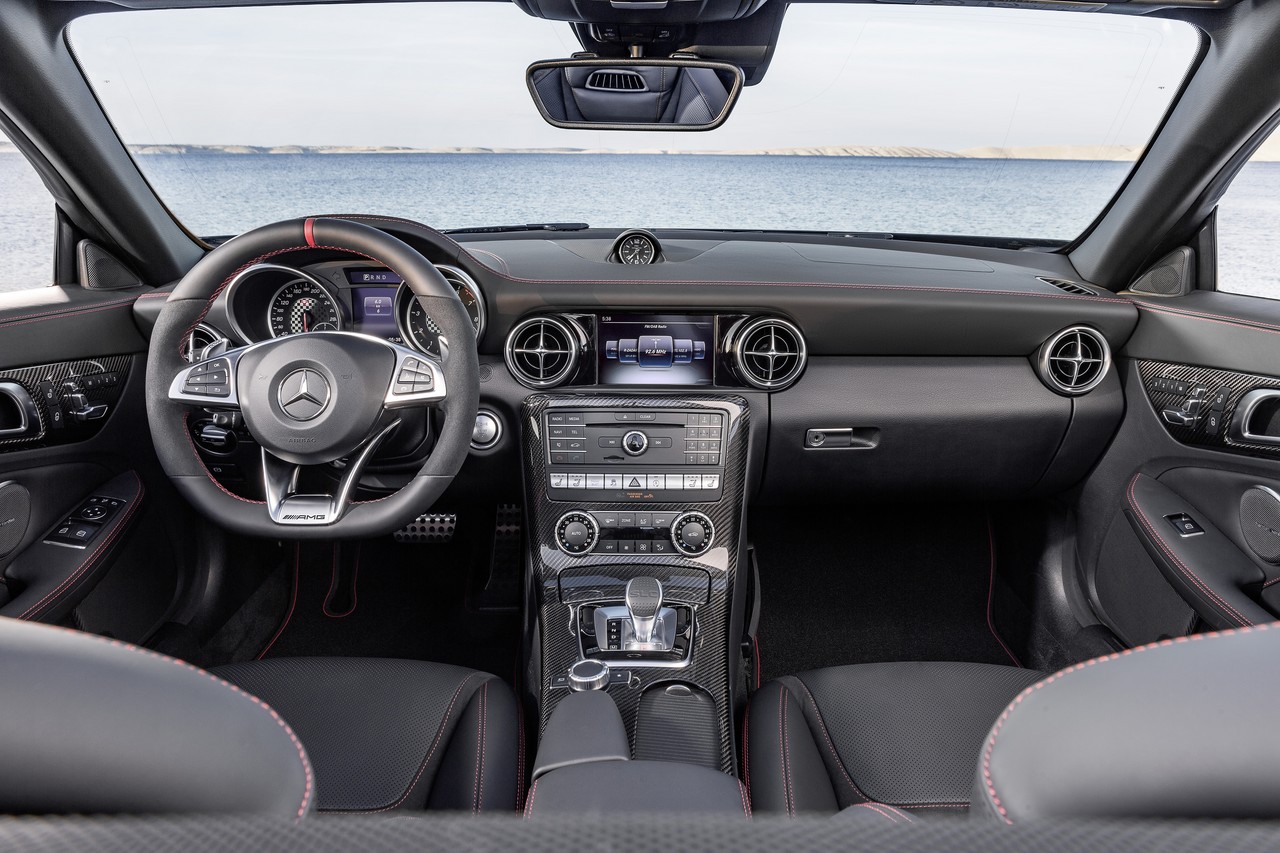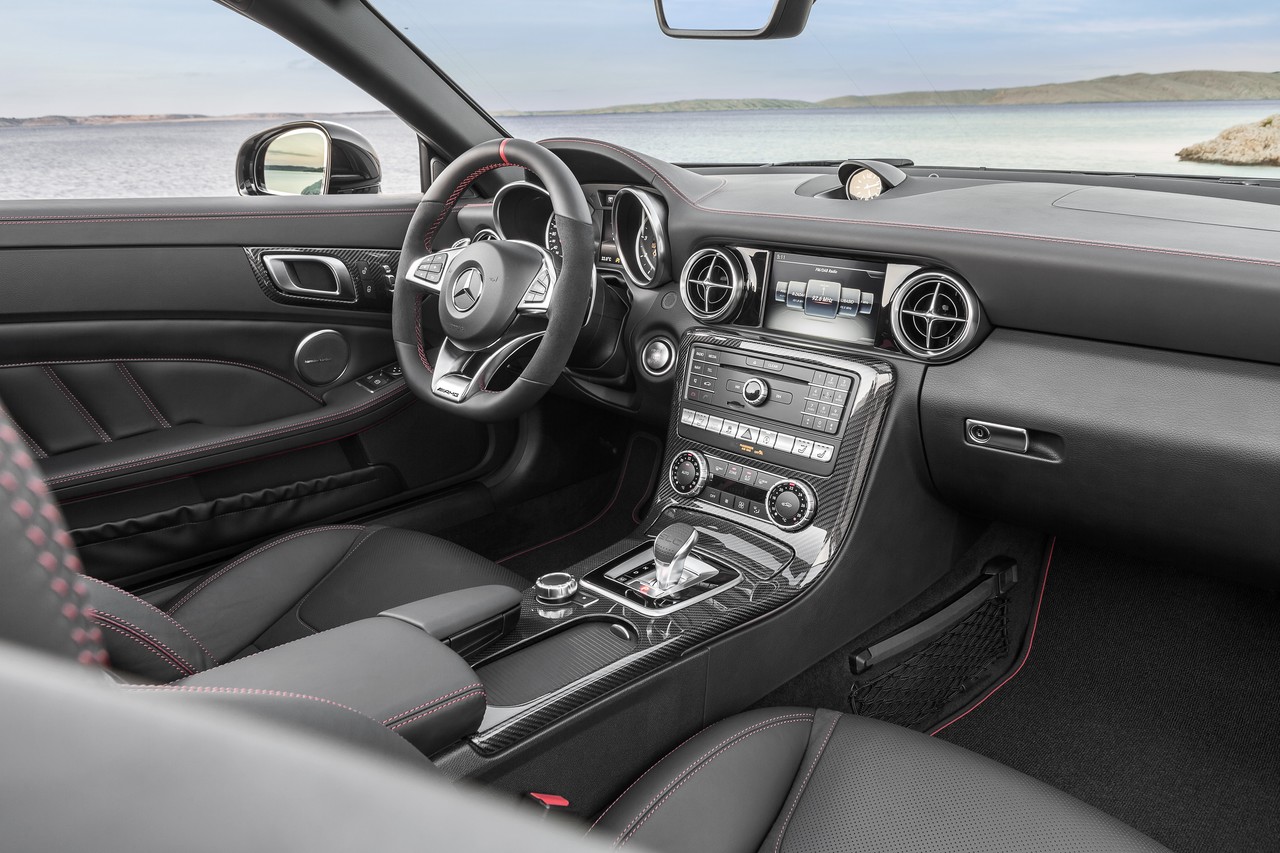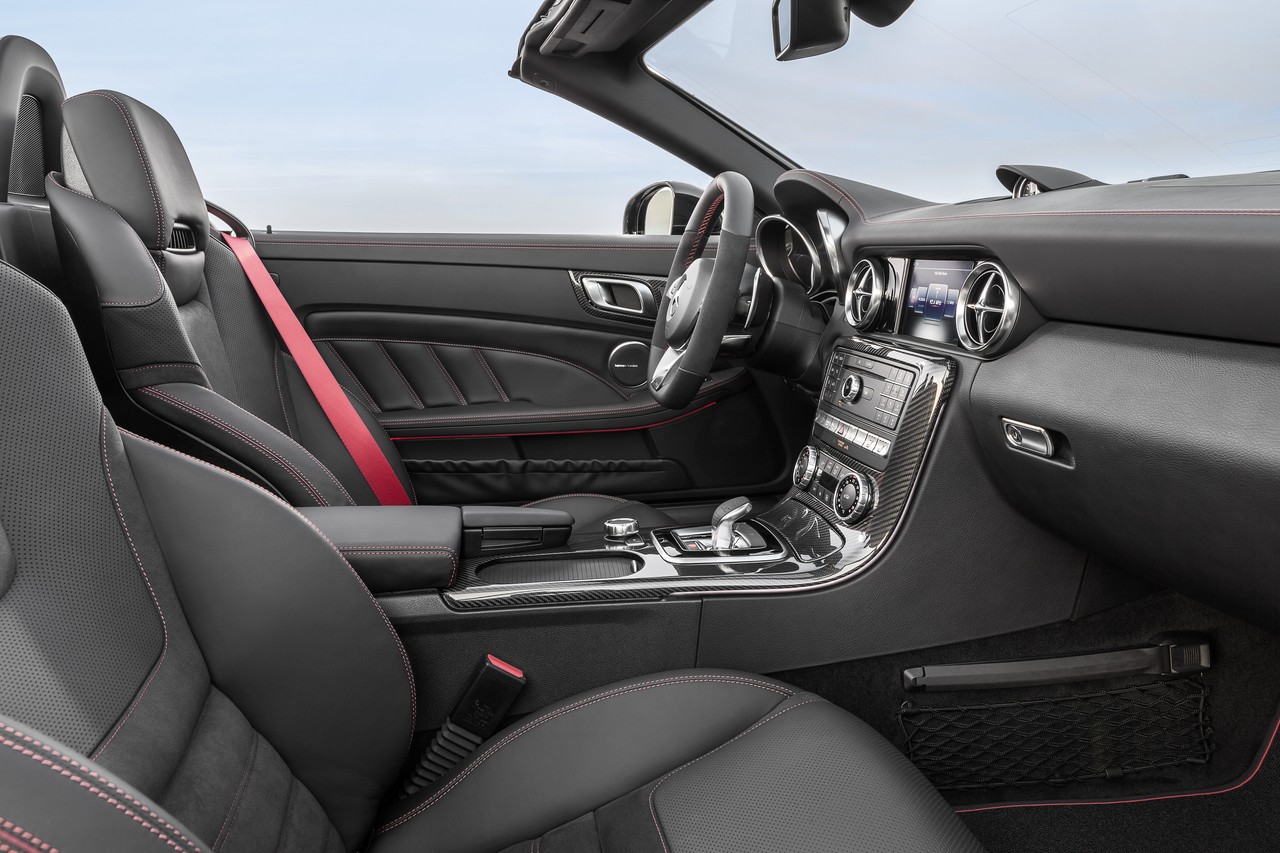
- Responsive 3.0-litre biturbo M276 V6 engine improves weight distribution for more balanced handling
- Supportive front seats
- High standard of interior fit and finish
- Powerful brakes
- Low-speed suspension compliance?
- Tyre noise?
Overview
Commencing production in January 2016, the Mercedes-AMG R172 SLC 43 was a two-seat convertible with a power-operated hardtop roof. Manufactured in Bremen, Germany, the rear-wheel drive Mercedes-AMG SLC 43 was powered by a 3.0-litre biturbo V6 petrol engine that was mated to a nine-speed automatic transmission. The SLC 43 replaced the R172 SLK 55 , with the change in name intended to acknowledge the relationship with the C-Class with which the SLC shared technology.
M276 DE 30 AL: Biturbo V6 engine
The Mercedes-AMG SLC 43 was powered by the M276 DE 30 AL engine which had an aluminium alloy cylinder block with ‘Nanoslide’ coating for the cylinder liners, a forged steel crankshaft, an aluminium alloy cylinder head, chain-driven double overhead camshafts, independent intake and exhaust camshaft adjustment, four valves per cylinder, a variable-resonance intake manifold and direct injection via piezo injectors which operated at a pressure of up to 200 bar. For the SLC 43, the M276 engine was fitted with two turbochargers that provided relative charge pressure of 1.1 bar (15.95 psi).
The SLC 43 could accelerate from rest to 100 km/h in 4.7 seconds and had an electronically limited top speed of 250 km/h.
To minimise fuel consumption, the M276 engine had an ECO start/stop function that could shut down the engine when the SLC 43 was stationary in traffic and a coasting function that could disengage the driveline. Over the combined ADR 81/02 test cycle, fuel consumption for the SLC 43 was 7.9 litres per 100 kilometres.
| Engine | Trans. | Peak power | Peak torque | |
|---|---|---|---|---|
| SLC 43 | 3.0-litre M276 biturbo petrol V6 | 9sp auto | 270 kW at 5500-6000 rpm | 520 Nm at 2000-4200 rpm |
9G-Tronic transmission
For the Mercedes-AMG SLC 43, the M276 engine was mated to the nine-speed ‘9G-Tronic’ automatic transmission which had been adapted for fast gearshifts and could be controlled via steering wheel gearshift paddles. Using the ‘Dynamic Select’ button on the centre console, the driver could select from five transmission modes to adjust throttle response, transmission behaviour, suspension damping (for models with electronically-controlled dampers) and steering weight. Specifically,
- Eco: designed for maximum fuel efficiency and activates the start/stop and coasting functions;
- Comfort: provided early upshifts and ‘comfort’ settings for the suspension and steering assistance;
- Sport: provided greater throttle response, faster gearshifts, a greater willingness to downshift and enabled the double-declutching function. Also provided firmer suspension damping and reduced power steering assistance;
- Sport+: even greater throttle response, increased ‘acoustic emphasis’ for double-declutching on downshifts, selective torque control on upshifts with cylinder suppression for faster gearshifts and a higher idle speed for greater acceleration from rest. Also provided firmer suspension and reduced power steering assistance; and,
- Individual: enabled the driver to customise settings and functions.
Independently of the above modes, a ‘Manual’ mode could be activated using a separate button next to the gear selector lever which provided gearshifts that were twice as fast as the other transmission modes. In ‘Manual’ mode, the transmission stayed in the selected gear and did not automatically shift up when engine speed reached its limit.
Suspension
The Mercedes-AMG SLC 43 had three-link front suspension with MacPherson struts and multi-link rear suspension. According to Mercedes, the three-link front axle had stiffer steering knuckles, improved elastokinematics, increased negative camber and newly developed wishbone guide bearings for more agile cornering, more precise and direct suspension feedback and higher cornering speeds. Furthermore, the four-link rear axle had ‘optimised elastokinematics, increased negative camber and special forged-aluminium track rods’ for improved driving dynamics and greater control when driven at the limit.
Available as an extra-cost option, ‘AMG Ride Control’ included electronically-controlled dampers which adjusted damping forces at each individual wheel automatically and continuously. The settings for the dampers were adjusted when the Comfort, Sport and Sport+ modes were engaged via the ‘Dynamic Select’ system.
Steering
The Mercedes-AMG SLC 43 had rack-and-pinion steering with a ratio of 15.5:1. Steering power assistance was variable in the Comfort and Sport modes, and could be personalised in Individual mode.
Safety equipment
Standard safety equipment for the Mercedes-AMG R172 SLC 43 included dual front airbags, front seat-mounted side airbags, front door-mounted window bags, ABS, electronic brake force distribution, brake assist, electronic stability control, traction control, driver fatigue monitoring (‘Attention Assist’), active front seat head restraints and front seatbelts with pre-tensioners and load limiters.
Beyond this, the Mercedes-AMG R172 SLC 43 was also fitted with the following safety technologies:
- Active Brake Assist (radar-based collision warning with autonomous braking and adaptive Brake Assist): operating at speeds up to 250 km/h to monitor the traffic ahead and at speeds up to 50 km/h for stationary objects, Active Brake Assist would issue a visual warning (when driving at speeds over 7 km/h) and an optical warning (when driving at speeds over 30 km/h if there was a collision risk. At speeds below 105 km/h (250 km/h in conjunction with Distronic Plus), Active Brake Assist would initially provide partial autonomous braking to reduce vehicle speed and alert the driver. Furthermore, adaptive Brake Assist would calculate the braking force required and prime the braking system for optimum response when the driver depressed the brake pedal. If the driver did not respond and a collision was unavoidable, then maximum braking force would be applied to reduce vehicle speed. At initial vehicle speeds of up to 40 km/h, rear-end collisions could be prevented;
- Distronic Plus (adaptive cruise control with brake warning): an ‘adaptive’ cruise control system which used two short-range radar sensors positioned behind the front bumper to monitor the road up to 30 metres ahead, and a long-range radar located behind the radiator grille which had a range of 200 metres. Operating at speeds up to 200 km/h, Distronic Plus used an electronic control unit to analyse the information from both radar systems to calculate the engine, automatic transmission and braking parameters required for proximity control. As such, Distronic Plus could automatically apply the brakes to prevent the vehicle from becoming too close to traffic ahead (the time interval could be specified) and accelerate back to the set speed when traffic allowed. To accelerate from rest, the driver only needed to operate the Distronic stalk on the steering column or briefly depress the accelerator pedal. With Distronic Plus, automatic deceleration of up to four (4) m/s2was possible. If Distronic Plus detected that heavier braking was required, a warning light would illuminate in the instrument cluster and be accompanied by an audible warning. Furthermore, the electronic proximity control system could be activated independently of Distronic Plus at speeds over 30 km/h to alert the driver if they were approaching another vehicle too rapidly;
- Mercedes-Benz’s ‘Pre-Safe’: could anticipate and prepare for collisions by tensioning the seatbelts and closing the windows;
- Blind spot assist (passive): used two radar sensors in the rear of the vehicle to warn the driver before an indicated lane-change if a vehicle is in the driver’s blind spot;
- Lane keeping assist (passive): used a camera behind the windscreen to monitor lane markings and detect if the vehicle was drifting outside its lane. If so, acoustic and visual warnings would be issued;
- Attention Assist: operated at speeds in excess of 80 km/h and assessed driver behaviour and steering movements for signs of drowsiness; if detected, the driver would be provided with visual and audible warnings; and,
- An ‘active bonnet’ which, in the event of a pedestrian collision, would rise to create clearance from ‘hard points’ in the engine bay and reduce the severity of the pedestrian’s subsequent impact.
Wheels, tyres and brakes
The Mercedes-AMG R172 SLC 43 had 8.0J x 18-inch front wheels with 235/40 ZR18 tyres and 9.0J x 18-inch rear wheels with 255/35 ZR18 tyres. Furthermore, the SLC 43 had 360 mm by 36 mm ventilated front brake discs and 330 mm by 22 mm solid rear discs.
Features: Mercedes-AMG R172 SLC 43
The Mercedes-AMG SLC 43 was equipped with Mercedes’ ‘COMAND Online’ multi-media system which included a 17.8 cm TFT colour display, HDD navigation with SUNA live traffic updates and three years of map updates, CD/DVD player, an SD memory card a lot, Bluetooth interface for telephony and audio streaming, ‘Linguatronic’ voice recognition, internet browser with integrated Mercedes-Benz apps, and smartphone integration via Apple CarPlay and Google Android Auto.
Beyond this, standard features for the Mercedes-AMG SLC 43 included 18-inch AMG multi-spoke alloy wheels with gloss black finish, a Harman Kardon Logic 7 surround sound system, black leather seats, power adjustable front sports seats with AMG Nappa leather and ‘Dinamica’ micro-fibre upholstery, red seatbelts and red contrasting stitching, air conditioning, ‘Airscarf’ neck-level heating for the front seats, cruise control with variable speed limiter (‘Speedtronic’), LED daytime running lights, dusk-sensing headlights, rain-sensing wipers, a rear view camera, a nappa leather steering wheel with steering wheel gearshift paddles, remote central locking with proximity key and push-button start (‘keyless go’), power adjustable and heated door mirrors, auto-dimming driver’s side door and interior rear-view mirrors, power windows, memory settings (for the front seats, steering column and door mirror positions), a height and reach adjustable steering wheel, a panoramic sunroof, a 12 volt power socket, illuminated vanity mirrors, light carbon-grain aluminium trim, AMG floor mats, AMG illuminated door sill panels, AMG instrument cluster with Racetimer and an 11.4 cm colour driving display, tyre pressure monitoring, a trip computer, an anti-theft alarm system and an immobiliser
As standard, the Mercedes-AMG SLC 43 was also equipped with:
- LED Intelligent Light System: provided variable lighting and five selectable programs: motorway mode, cornering light function, camera-based active light function, roundabout light function and enhanced fog light function;
- Adaptive Highbeam Assist Plus: active at speeds above 30 km/h, Adaptive Highbeam Assist Plus used a camera positioned behind the windscreen to detect vehicles ahead of the SLC and oncoming traffic. Using this information, Adaptive Highbeam Assist Plus provided continuous, dazzle-free high beam lights and could use a mechanism in the headlamp module to mask a portion of the cone of light from the LED headlights; and,
- Parktronic including Parking Guidance: used front and rear parking sensors to detect parking spaces and displayed the necessary steering wheel movements for parking manoeuvres.
Specifiations
Related links
- Daimler media: The new SLC – new name, new dynamic (December 2015)
- Wikipedia.org: Mercedes-Benz R172 SLK-Class
